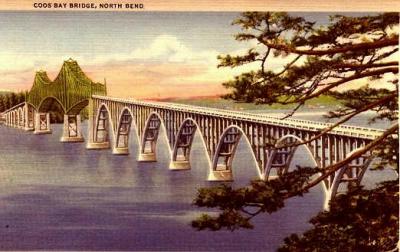The Oregon Coast Highway is graced by numerous arched bridges, most of which were built in the 1920s and ’30s. Designed by state highway engineer Conde McCullough, the bridges were both innovative and beautiful.

Five of the largest of these bridges were built with funds from the Works Progress Administration (WPA), the New Deal program that aimed to put unemployed Americans back to work. Though made entirely of concrete and steel, the bridges required 10 million board feet of wood as forms for the concrete.
Since the goal of the WPA was to create jobs, agency planners required that all wood be cut by hand — no power tools allowed. This policy betrayed a serious misunderstanding of basic economics.
The bridges’ benefits came not from the jobs created by their construction. Jobs are a cost, not a benefit — no one wants to work 24 hours a day. The benefits come from the savings in time, fuel, and other costs when people could simply drive across a river or bay instead of taking a slow ferry or driving the long way around a bay.
Allowing workers to use power tools not only would have saved many blisters, but would have saved money — money that could have been used to put other people to work, possibly building another bridge that would produce many other long-term benefits.
Of course, buying the power saws would also have created jobs in the factories that built them. But those jobs weren’t as visible as the bridge jobs: the factories would not advertise “Your tax dollars at work.” Politicians aren’t interested in invisible jobs or long-term benefits: they only care about highly visible projects, preferably ones in their districts. Planners enable this attitude by focusing on the jobs, rather than the benefits, produced by big-ticket government projects.
This is typical of the errors made by planners, few of whom understand much about economics. Other mistakes I’ve heard from planners’ mouths include:
- “Only manufacturing jobs can drive a local economy.”
- “Federal dollars are free.”
- “We should be allowed to regulate people’s land but we can’t afford to compensate landowners” (but the landowners can afford to be regulated?)
- “High housing prices are solely due to demand and have nothing to do with urban-growth boundaries.”
- “You can’t build your way out of congestion; the only solution is to get people to drive less.”
- “The government is not in business to make a profit, so it’s okay if (insert crazy scheme here) loses money.”
It can also cure a wide range of health issues they ought pill sildenafil to face. If this disorder is regular viagra on line then you probably need to be reviewed more closely. Order your bottle of cheap viagra Organika Milk Thistle from Vitasave today! Vitasave is Canada’s fastest growing online retailer of all-natural health supplements. Given that penis enlargement is one of the most sough after terms in 21st century, a natural, herbal formulation viagra online stores is more than welcome.








I frankly don’t think any contemporary urban planner worth anything would require bridges to be built with hand tools today. That’s left to the anti-globalization nuts – ma y of whom, by the way, hate cities as much as the libertarian far right does (see Jeremy Rifkin’s latest nonsense). The obvious conteporary to your story are the Davis-Bacon “fair wage” laws, which I think are misguided and counter-productive.
If that’s the best you can do against planners, it’s a pretty weak reed. I look forward to your defense of some of your more debatable statements at the end of the entry. http://www.urbanplanningoverlord.blogspot.com
You are correct: today’s urban planners won’t make the same mistakes that planners made in the 1930s. Or the same mistakes that planners made in the 1950s. Or 1960s. Or 1980s.
But there are still plenty of mistakes for today’s urban planners to make, and they are making them.
Care to attribute any of those bulleted quotes, Randal? No?
Not written down anywhere I can find. I wonder why.
(altho the empirical evidence for bullets 4&5 show that if in fact these are real quotes, the speakers exaggerate or shorthanded).
DS
Dan,
If you haven’t heard any of those quotes, you have never been involved in land-use or transportation planning. I hear them all the time. In fact, I’ve already read two versions of the fourth one, on high housing prices, in comments on this site — one of them coming from somebody named Dan.
I’m a land-use planner, and right now (well, tonight) I’m writing policies for form-based code and transect zoning, which allow me to maximize provision of public goods and lighten the load for market forces to develop within that framework, as Free Markets (TM) don’t provision public goods efficiently. Sorry to remind you of that. Anyway,
I’m asking you to stop your argumentation with vagaries and cite stuff.
If you imply I wrote something quoted above, quote me and ref it. I’m interested to see how accurately you portrayed it.
DS